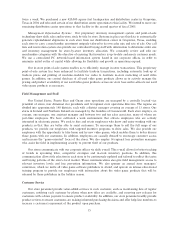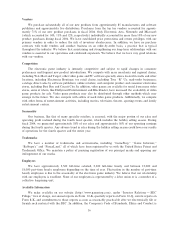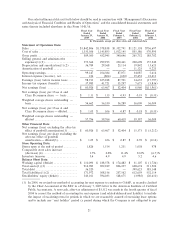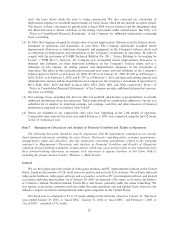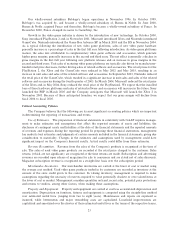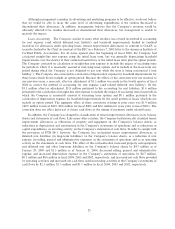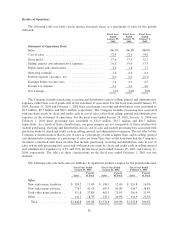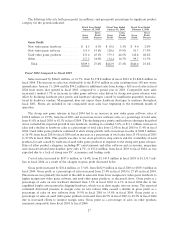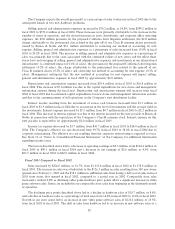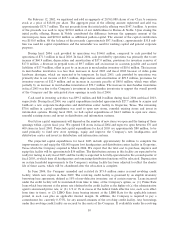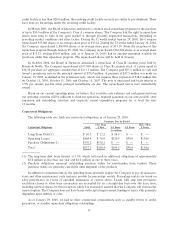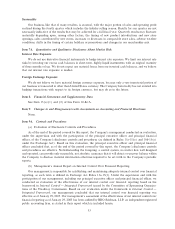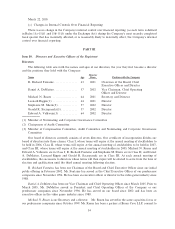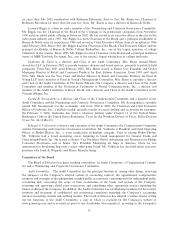GameStop 2004 Annual Report Download - page 32
Download and view the complete annual report
Please find page 32 of the 2004 GameStop annual report below. You can navigate through the pages in the report by either clicking on the pages listed below, or by using the keyword search tool below to find specific information within the annual report.Although management considers its advertising and marketing programs to be eÅective, we do not believe
that we would be able to incur the same level of advertising expenditures if the vendors decreased or
discontinued their allowances. In addition, management believes that the Company's revenues would be
adversely aÅected if its vendors decreased or discontinued their allowances, but management is unable to
quantify the impact.
Lease Accounting. The Company, similar to many other retailers, has revised its method of accounting
for rent expense (and related deferred rent liability) and leasehold improvements funded by landlord
incentives for allowances under operating leases (tenant improvement allowances) to conform to GAAP, as
recently clariÑed by the Chief Accountant of the SEC in a February 7, 2005 letter to the American Institute of
CertiÑed Public Accountants. For all stores opened since the beginning of Ñscal 2002, the Company had
calculated straight-line rent expense using the initial lease term, but was generally depreciating leasehold
improvements over the shorter of their estimated useful lives or the initial lease term plus the option periods.
The Company corrected its calculation of straight-line rent expense to include the impact of escalating rents
for periods in which it is reasonably assured of exercising lease options and to include in the lease term any
period during which the Company is not obligated to pay rent while the store is being constructed (""rent
holiday''). The Company also corrected its calculation of depreciation expense for leasehold improvements for
those leases which do not include an option period. Because the eÅects of the correction were not material to
any previous years, a non-cash, after-tax adjustment of $3.3 million was made in the fourth quarter of Ñscal
2004 to correct the method of accounting for rent expense (and related deferred rent liability). Of the
$3.3 million after-tax adjustment, $1.8 million pertained to the accounting for rent holidays, $1.4 million
pertained to the calculation of straight-line rent expense to include the impact of escalating rents for periods in
which the Company is reasonably assured of exercising lease options and $0.1 million pertained to the
calculation of depreciation expense for leasehold improvements for the small portion of leases which do not
include an option period. The aggregate eÅect of these corrections relating to prior years was $1.9 million
($0.9 million for Ñscal 2003, $0.4 million for Ñscal 2002 and $0.6 million for years prior to Ñscal 2002). The
correction does not aÅect historical or future cash Öows or the timing of payments under related leases.
In addition, the Company has changed its classiÑcation of tenant improvement allowances on its balance
sheets and statements of cash Öows. Like many other retailers, the Company had historically classiÑed tenant
improvement allowances as reductions of property and equipment on the Company's balance sheets, as
reductions in depreciation and amortization in the Company's statements of operations and as reductions in
capital expenditures, an investing activity, on the Company's statements of cash Öows. In order to comply with
the provisions of FTB 88-1, however, the Company has reclassiÑed tenant improvement allowances as
deferred rent liabilities (in long-term liabilities) on the Company's balance sheets, as a reduction of rent
expense (in selling, general and administrative expenses) in the statements of operations and as an operating
activity on the statements of cash Öows. The eÅect of this reclassiÑcation increased property and equipment
and deferred rent and other long-term liabilities on the Company's balance sheets by $4.7 million as of
January 29, 2005 and $3.3 million as of January 31, 2004, decreased selling, general and administrative
expense and increased depreciation expense in the Company's statements of operations by $0.7 million,
$0.5 million and $0.6 million in Ñscal 2004, 2003 and 2002, respectively, and increased net cash Öows provided
by operating activities and increased net cash Öows used in investing activities in the Company's statements of
cash Öows by $2.3 million, $1.5 million and $1.1 million in Ñscal 2004, 2003 and 2002, respectively.
25


